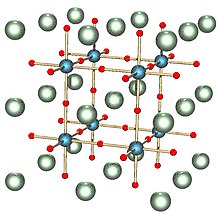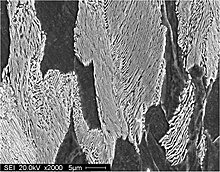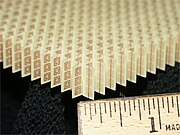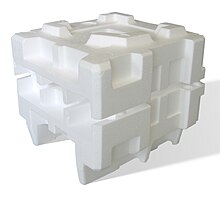From Wikipedia, the free encyclopedia
The
interdisciplinary field of
materials science, also commonly termed
materials science and engineering is the design and discovery of new materials, particularly
solids. The intellectual origins of materials science stem from the
Enlightenment, when researchers began to use analytical thinking from
chemistry,
physics, and
engineering to understand ancient,
phenomenological observations in
metallurgy and
mineralogy.
Materials science still incorporates elements of physics, chemistry,
and engineering. As such, the field was long considered by academic
institutions as a sub-field of these related fields. Beginning in the
1940s, materials science began to be more widely recognized as a
specific and distinct field of science and engineering, and major
technical universities around the world created dedicated schools of the
study, within either the Science or Engineering schools, hence the
naming.
- Materials science is a syncretic discipline hybridizing
metallurgy, ceramics, solid-state physics, and chemistry. It is the
first example of a new academic discipline emerging by fusion rather
than fission.[3]
Many of the most pressing scientific problems humans currently face
are due to the limits of the materials that are available and how they
are used. Thus, breakthroughs in materials science are likely to affect
the future of technology significantly.
[4][5]
Materials scientists emphasize understanding how the history of a material (its
processing)
influences its structure, and thus the material's properties and
performance. The understanding of processing-structure-properties
relationships is called the
§ materials paradigm. This paradigm is used to advance understanding in a variety of research areas, including
nanotechnology,
biomaterials, and metallurgy. Materials science is also an important part of
forensic engineering and
failure analysis
- investigating materials, products, structures or components which
fail or do not function as intended, causing personal injury or damage
to property. Such investigations are key to understanding, for example,
the causes of various
aviation accidents and incidents.
History
The material of choice of a given era is often a defining point. Phrases such as
Stone Age,
Bronze Age,
Iron Age, and
Steel Age are historic, if arbitrary examples. Originally deriving from the manufacture of
ceramics
and its putative derivative metallurgy, materials science is one of the
oldest forms of engineering and applied science. Modern materials
science evolved directly from
metallurgy,
which itself evolved from mining and (likely) ceramics and earlier from
the use of fire. A major breakthrough in the understanding of materials
occurred in the late 19th century, when the American scientist
Josiah Willard Gibbs demonstrated that the
thermodynamic properties related to
atomic structure in various
phases are related to the physical properties of a material. Important elements of modern materials science are a product of the
space race: the understanding and
engineering of the metallic
alloys, and
silica and
carbon
materials, used in building space vehicles enabling the exploration of
space. Materials science has driven, and been driven by, the development
of revolutionary technologies such as
rubbers,
plastics,
semiconductors, and
biomaterials.
Before the 1960s (and in some cases decades after), many
materials science departments were named
metallurgy
departments, reflecting the 19th and early 20th century emphasis on
metals. The growth of materials science in the United States was
catalyzed in part by the
Advanced Research Projects Agency,
which funded a series of university-hosted laboratories in the early
1960s "to expand the national program of basic research and training in
the materials sciences."
[6] The field has since broadened to include every class of materials, including
ceramics,
polymers,
semiconductors,
magnetic materials,
medical implant
materials, biological materials, and nanomaterials, with modern
materials classed within 3 distinct groups: Ceramic, Metal or Polymer.
The prominent change in materials science during the last two decades is
active usage of computer simulation methods to find new compounds,
predict various properties, and as a result design new materials at a
much greater rate than previous years.
Fundamentals
The materials paradigm represented in the form of a tetrahedron.
A material is defined as a substance (most often a solid, but other
condensed phases can be included) that is intended to be used for
certain applications.
[7]
There are a myriad of materials around us—they can be found in anything
from buildings to spacecraft. Materials can generally be further
divided into two classes:
crystalline and
non-crystalline. The traditional examples of materials are
metals,
semiconductors,
ceramics and
polymers.
[8] New and advanced materials that are being developed include
nanomaterials,
biomaterials,
[9] and
energy materials to name a few.
The basis of materials science involves studying the structure of materials, and relating them to their
properties.
Once a materials scientist knows about this structure-property
correlation, they can then go on to study the relative performance of a
material in a given application. The major determinants of the structure
of a material and thus of its properties are its constituent chemical
elements and the way in which it has been processed into its final form.
These characteristics, taken together and related through the laws of
thermodynamics and
kinetics, govern a material's
microstructure, and thus its properties.
Structure
As
mentioned above, structure is one of the most important components of
the field of materials science. Materials science examines the structure
of materials from the atomic scale, all the way up to the macro scale.
Characterization is the way materials scientists examine the structure of a material. This involves methods such as diffraction with
X-rays,
electrons, or
neutrons, and various forms of
spectroscopy and
chemical analysis such as
Raman spectroscopy,
energy-dispersive spectroscopy (EDS),
chromatography,
thermal analysis,
electron microscope analysis, etc. Structure is studied at various levels, as detailed below.
Atomic structure
This
deals with the atoms of the materials, and how they are arranged to
give molecules, crystals, etc. Much of the electrical, magnetic and
chemical properties of materials arise from this level of structure. The
length scales involved are in angstroms.
The way in which the atoms and molecules are bonded and arranged is
fundamental to studying the properties and behavior of any material.
Nanostructure
Nanostructure deals with objects and structures that are in the 1—100 nm range.
[10]
In many materials, atoms or molecules agglomerate together to form
objects at the nanoscale. This causes many interesting electrical,
magnetic, optical, and mechanical properties.
In describing nanostructures it is necessary to differentiate between the number of dimensions on the
nanoscale.
Nanotextured surfaces have
one dimension on the nanoscale, i.e., only the thickness of the surface of an object is between 0.1 and 100 nm. Nanotubes have
two dimensions
on the nanoscale, i.e., the diameter of the tube is between 0.1 and
100 nm; its length could be much greater. Finally, spherical
nanoparticles have
three dimensions on the nanoscale, i.e., the particle is between 0.1 and 100 nm in each spatial dimension. The terms nanoparticles and
ultrafine particles
(UFP) often are used synonymously although UFP can reach into the
micrometre range. The term 'nanostructure' is often used when referring
to magnetic technology. Nanoscale structure in biology is often called
ultrastructure.
Materials which atoms and molecules form constituents in the
nanoscale (i.e., they form nanostructure) are called nanomaterials.
Nanomaterials are subject of intense research in the materials science
community due to the unique properties that they exhibit.
Microstructure
Microstructure of pearlite.
Microstructure is defined as the structure of a prepared surface or
thin foil of material as revealed by a microscope above 25×
magnification. It deals with objects from 100 nm to a few cm. The
microstructure of a material (which can be broadly classified into
metallic, polymeric, ceramic and composite) can strongly influence
physical properties such as strength, toughness, ductility, hardness,
corrosion resistance, high/low temperature behavior, wear resistance,
and so on. Most of the traditional materials (such as metals and
ceramics) are microstructured.
The manufacture of a perfect
crystal of a material is physically impossible. For example, any crystalline material will contain
defects such as
precipitates, grain boundaries (
Hall–Petch relationship),
vacancies, interstitial atoms or substitutional atoms. The
microstructure of materials reveals these larger defects, so that they
can be studied, with significant advances in simulation resulting in
exponentially increasing understanding of how defects can be used to
enhance material properties.
Macro structure
Macro
structure is the appearance of a material in the scale millimeters to
meters—it is the structure of the material as seen with the naked eye.
Crystallography
Crystal structure of a perovskite with a chemical formula ABX
3.
[11]
Crystallography is the science that examines the arrangement of atoms
in crystalline solids. Crystallography is a useful tool for materials
scientists. In single crystals, the effects of the crystalline
arrangement of atoms is often easy to see macroscopically, because the
natural shapes of crystals reflect the atomic structure. Further,
physical properties are often controlled by crystalline defects. The
understanding of crystal structures is an important prerequisite for
understanding crystallographic defects. Mostly, materials do not occur
as a single crystal, but in polycrystalline form, i.e., as an aggregate
of small crystals with different orientations. Because of this, the
powder diffraction method, which uses diffraction patterns of
polycrystalline samples with a large number of crystals, plays an
important role in structural determination.
Most materials have a crystalline structure, but some important
materials do not exhibit regular crystal structure.
Polymers display varying degrees of crystallinity, and many are completely noncrystalline.
Glass, some ceramics, and many natural materials are
amorphous,
not possessing any long-range order in their atomic arrangements. The
study of polymers combines elements of chemical and statistical
thermodynamics to give thermodynamic and mechanical, descriptions of
physical properties.
Bonding
To obtain a full understanding of the material structure and how it
relates to its properties, the materials scientist must study how the
different atoms, ions and molecules are arranged and bonded to each
other. This involves the study and use of
quantum chemistry or
quantum physics.
Solid-state physics,
solid-state chemistry and
physical chemistry are also involved in the study of bonding and structure.
Synthesis and processing
Synthesis
and processing involves the creation of a material with the desired
micro-nanostructure. From an engineering standpoint, a material cannot
be used in industry if no economical production method for it has been
developed. Thus, the processing of materials is vital to the field of
materials science.
Different materials require different processing or synthesis
methods. For example, the processing of metals has historically been
very important and is studied under the branch of materials science
named
physical metallurgy. Also, chemical and physical methods are also used to synthesize other materials such as
polymers,
ceramics,
thin films, etc. As of the early 21st century, new methods are being developed to synthesize nanomaterials such as
graphene.
Thermodynamics
A phase diagram for a binary system displaying a eutectic point.
Thermodynamics is concerned with
heat and
temperature and their relation to
energy and
work. It defines
macroscopic variables, such as
internal energy,
entropy, and
pressure,
that partly describe a body of matter or radiation. It states that the
behavior of those variables is subject to general constraints, that are
common to all materials, not the peculiar properties of particular
materials. These general constraints are expressed in the four laws of
thermodynamics. Thermodynamics describes the bulk behavior of the body,
not the microscopic behaviors of the very large numbers of its
microscopic constituents, such as molecules. The behavior of these
microscopic particles is described by, and the laws of thermodynamics
are derived from,
statistical mechanics.
The study of thermodynamics is fundamental to materials science.
It forms the foundation to treat general phenomena in materials science
and engineering, including chemical reactions, magnetism,
polarizability, and elasticity. It also helps in the understanding of
phase diagrams and phase equilibrium.
Kinetics
Chemical kinetics
is the study of the rates at which systems that are out of equilibrium
change under the influence of various forces. When applied to materials
science, it deals with how a material changes with time (moves from
non-equilibrium to equilibrium state) due to application of a certain
field. It details the rate of various processes evolving in materials
including shape, size, composition and structure.
Diffusion is important in the study of kinetics as this is the most common mechanism by which materials undergo change.
Kinetics is essential in processing of materials because, among
other things, it details how the microstructure changes with application
of heat.
In research
Materials science has received much attention from researchers. In most universities, many departments ranging from
physics to
chemistry to
chemical engineering,
along with materials science departments, are involved in materials
research. Research in materials science is vibrant and consists of many
avenues. The following list is in no way exhaustive. It serves only to
highlight certain important research areas.
Nanomaterials
Nanomaterials describe, in principle, materials of which a single
unit is sized (in at least one dimension) between 1 and 1000 nanometers
(10
−9 meter) but is usually 1—100 nm.
Nanomaterials research takes a materials science-based approach to
nanotechnology, leveraging advances in materials
metrology and synthesis which have been developed in support of
microfabrication research. Materials with structure at the nanoscale often have unique optical, electronic, or mechanical properties.
The field of nanomaterials is loosely organized, like the
traditional field of chemistry, into organic (carbon-based)
nanomaterials such as fullerenes, and inorganic nanomaterials based on
other elements, such as silicon. Examples of nanomaterials include
fullerenes,
carbon nanotubes,
nanocrystals, etc.
Biomaterials
A biomaterial is any matter, surface, or construct that interacts with biological systems. The study of biomaterials is called
bio materials science.
It has experienced steady and strong growth over its history, with many
companies investing large amounts of money into developing new
products. Biomaterials science encompasses elements of
medicine,
biology,
chemistry,
tissue engineering, and materials science.
Biomaterials can be derived either from nature or synthesized in a
laboratory using a variety of chemical approaches using metallic
components,
polymers,
bioceramics, or
composite materials.
They are often used and/or adapted for a medical application, and thus
comprises whole or part of a living structure or biomedical device which
performs, augments, or replaces a natural function. Such functions may
be benign, like being used for a
heart valve, or may be
bioactive with a more interactive functionality such as
hydroxylapatite coated
hip implants.
Biomaterials are also used every day in dental applications, surgery,
and drug delivery. For example, a construct with impregnated
pharmaceutical products can be placed into the body, which permits the
prolonged release of a drug over an extended period of time. A
biomaterial may also be an
autograft,
allograft or
xenograft used as an
organ transplant material.
Electronic, optical, and magnetic
Semiconductors, metals, and ceramics are used today to form highly
complex systems, such as integrated electronic circuits, optoelectronic
devices, and magnetic and optical mass storage media. These materials
form the basis of our modern computing world, and hence research into
these materials is of vital importance.
Semiconductors are a traditional example of these types of materials. They are materials that have properties that are intermediate between
conductors and
insulators. Their electrical conductivities are very sensitive to impurity concentrations, and this allows for the use of
doping to achieve desirable electronic properties. Hence, semiconductors form the basis of the traditional computer.
This field also includes new areas of research such as
superconducting materials,
spintronics,
metamaterials, etc. The study of these materials involves knowledge of materials science and
solid-state physics or
condensed matter physics.
Computational science and theory
With
the increase in computing power, simulating the behavior of materials
has become possible. This enables materials scientists to discover
properties of materials formerly unknown, as well as to design new
materials. Up until now, new materials were found by time-consuming
trial and error processes. But, now it is hoped that computational
methods could drastically reduce that time, and allow tailoring
materials properties. This involves simulating materials at all length
scales, using methods such as
density functional theory,
molecular dynamics, etc.
In industry
Radical
materials advances
can drive the creation of new products or even new industries, but
stable industries also employ materials scientists to make incremental
improvements and troubleshoot issues with currently used materials.
Industrial applications of materials science include materials design,
cost-benefit tradeoffs in industrial production of materials, processing
methods (
casting,
rolling,
welding,
ion implantation,
crystal growth,
thin-film deposition,
sintering,
glassblowing, etc.), and analytic methods (characterization methods such as
electron microscopy,
X-ray diffraction,
calorimetry,
nuclear microscopy (HEFIB),
Rutherford backscattering,
neutron diffraction, small-angle X-ray scattering (SAXS), etc.).
Besides material characterization, the material scientist or
engineer also deals with extracting materials and converting them into
useful forms. Thus ingot casting, foundry methods, blast furnace
extraction, and electrolytic extraction are all part of the required
knowledge of a materials engineer. Often the presence, absence, or
variation of minute quantities of secondary elements and compounds in a
bulk material will greatly affect the final properties of the materials
produced. For example, steels are classified based on 1/10 and 1/100
weight percentages of the carbon and other alloying elements they
contain. Thus, the extracting and purifying methods used to extract iron
in a blast furnace can affect the quality of steel that is produced.
Ceramics and glasses
Si3N4 ceramic bearing parts
Another application of material science is the structures of
ceramics and
glass
typically associated with the most brittle materials. Bonding in
ceramics and glasses uses covalent and ionic-covalent types with SiO
2
(silica or sand) as a fundamental building block. Ceramics are as soft
as clay or as hard as stone and concrete. Usually, they are crystalline
in form. Most glasses contain a metal oxide fused with silica. At high
temperatures used to prepare glass, the material is a viscous liquid.
The structure of glass forms into an amorphous state upon cooling.
Windowpanes and eyeglasses are important examples. Fibers of glass are
also available. Scratch resistant Corning
Gorilla Glass
is a well-known example of the application of materials science to
drastically improve the properties of common components. Diamond and
carbon in its graphite form are considered to be ceramics.
Engineering ceramics are known for their stiffness and stability
under high temperatures, compression and electrical stress. Alumina,
silicon carbide, and
tungsten carbide
are made from a fine powder of their constituents in a process of
sintering with a binder. Hot pressing provides higher density material.
Chemical vapor deposition can place a film of a ceramic on another
material. Cermets are ceramic particles containing some metals. The wear
resistance of tools is derived from cemented carbides with the metal
phase of cobalt and nickel typically added to modify properties.
Composites
A 6 μm diameter carbon filament (running from bottom left to top right) siting atop the much larger human hair.
Filaments are commonly used for reinforcement in
composite materials.
Another application of materials science in industry is making
composite materials.
These are structured materials composed of two or more macroscopic
phases. Applications range from structural elements such as
steel-reinforced concrete, to the thermal insulating tiles which play a
key and integral role in NASA's
Space Shuttle thermal protection system which is used to protect the surface of the shuttle from the heat of re-entry into the Earth's atmosphere. One example is
reinforced Carbon-Carbon
(RCC), the light gray material which withstands re-entry temperatures
up to 1,510 °C (2,750 °F) and protects the Space Shuttle's wing leading
edges and nose cap. RCC is a laminated composite material made from
graphite rayon cloth and impregnated with a
phenolic resin.
After curing at high temperature in an autoclave, the laminate is
pyrolized to convert the resin to carbon, impregnated with furfural
alcohol in a vacuum chamber, and cured-pyrolized to convert the
furfural alcohol to carbon. To provide oxidation resistance for reuse ability, the outer layers of the RCC are converted to
silicon carbide.
Other examples can be seen in the "plastic" casings of television
sets, cell-phones and so on. These plastic casings are usually a
composite material made up of a thermoplastic matrix such as
acrylonitrile butadiene styrene (ABS) in which
calcium carbonate chalk,
talc,
glass fibers or
carbon fibers
have been added for added strength, bulk, or electrostatic dispersion.
These additions may be termed reinforcing fibers, or dispersants,
depending on their purpose.
Polymers
The repeating unit of the polymer polypropylene
Expanded polystyrene polymer packaging.
Polymers
are chemical compounds made up of a large number of identical
components linked together like chains. They are an important part of
materials science. Polymers are the raw materials (the resins) used to
make what are commonly called plastics and rubber. Plastics and rubber
are really the final product, created after one or more polymers or
additives have been added to a resin during processing, which is then
shaped into a final form. Plastics which have been around, and which are
in current widespread use, include
polyethylene,
polypropylene,
polyvinyl chloride (PVC),
polystyrene,
nylons,
polyesters,
acrylics,
polyurethanes, and
polycarbonates and also rubbers which have been around are natural rubber,
styrene-butadiene rubber,
chloroprene, and
butadiene rubber. Plastics are generally classified as
commodity,
specialty and
engineering plastics.
Polyvinyl chloride (PVC) is widely used, inexpensive, and annual
production quantities are large. It lends itself to a vast array of
applications, from
artificial leather to
electrical insulation and cabling,
packaging, and
containers. Its fabrication and processing are simple and well-established. The versatility of PVC is due to the wide range of
plasticisers
and other additives that it accepts. The term "additives" in polymer
science refers to the chemicals and compounds added to the polymer base
to modify its material properties.
Polycarbonate
would be normally considered an engineering plastic (other examples
include PEEK, ABS). Such plastics are valued for their superior
strengths and other special material properties. They are usually not
used for disposable applications, unlike commodity plastics.
Specialty plastics are materials with unique characteristics,
such as ultra-high strength, electrical conductivity,
electro-fluorescence, high thermal stability, etc.
The dividing lines between the various types of plastics is not
based on material but rather on their properties and applications. For
example,
polyethylene
(PE) is a cheap, low friction polymer commonly used to make disposable
bags for shopping and trash, and is considered a commodity plastic,
whereas
medium-density polyethylene (MDPE) is used for underground gas and water pipes, and another variety called
ultra-high-molecular-weight polyethylene
(UHMWPE) is an engineering plastic which is used extensively as the
glide rails for industrial equipment and the low-friction socket in
implanted
hip joints.
Metal alloys
Wire rope made from
steel alloy.
The study of metal alloys is a significant part of materials science.
Of all the metallic alloys in use today, the alloys of iron (
steel,
stainless steel,
cast iron,
tool steel,
alloy steels)
make up the largest proportion both by quantity and commercial value.
Iron alloyed with various proportions of carbon gives low, mid and
high carbon steels. An iron-carbon alloy is only considered steel if the carbon level is between 0.01% and 2.00%. For the steels, the
hardness
and tensile strength of the steel is related to the amount of carbon
present, with increasing carbon levels also leading to lower ductility
and toughness. Heat treatment processes such as quenching and tempering
can significantly change these properties, however. Cast Iron is defined
as an iron–carbon alloy with more than 2.00% but less than 6.67%
carbon. Stainless steel is defined as a regular steel alloy with greater
than 10% by weight alloying content of Chromium. Nickel and Molybdenum
are typically also found in stainless steels.
Other significant metallic alloys are those of
aluminium,
titanium,
copper and
magnesium.
Copper alloys have been known for a long time (since the
Bronze Age),
while the alloys of the other three metals have been relatively
recently developed. Due to the chemical reactivity of these metals, the
electrolytic extraction processes required were only developed
relatively recently. The alloys of aluminium, titanium and magnesium are
also known and valued for their high strength-to-weight ratios and, in
the case of magnesium, their ability to provide electromagnetic
shielding. These materials are ideal for situations where high
strength-to-weight ratios are more important than bulk cost, such as in
the aerospace industry and certain automotive engineering applications.
Semiconductors
The study of semiconductors is a significant part of materials science. A
semiconductor
is a material that has a resistivity between a metal and insulator. Its
electronic properties can be greatly altered through intentionally
introducing impurities or doping. From these semiconductor materials,
things such as
diodes,
transistors,
light-emitting diodes (LEDs), and analog and digital
electric circuits
can be built, making them materials of interest in industry.
Semiconductor devices have replaced thermionic devices (vacuum tubes) in
most applications. Semiconductor devices are manufactured both as
single discrete devices and as
integrated circuits
(ICs), which consist of a number—from a few to millions—of devices
manufactured and interconnected on a single semiconductor substrate.
[14]
Of all the semiconductors in use today,
silicon
makes up the largest portion both by quantity and commercial value.
Monocrystalline silicon is used to produce wafers used in the
semiconductor and electronics industry. Second to silicon,
gallium arsenide
(GaAs) is the second most popular semiconductor used. Due to its higher
electron mobility and saturation velocity compared to silicon, it is a
material of choice for high-speed electronics applications. These
superior properties are compelling reasons to use GaAs circuitry in
mobile phones, satellite communications, microwave point-to-point links
and higher frequency radar systems. Other semiconductor materials
include
germanium,
silicon carbide, and
gallium nitride and have various applications.
Relation to other fields
Materials
science evolved—starting from the 1960s—because it was recognized that
to create, discover and design new materials, one had to approach it in a
unified manner. Thus, materials science and engineering emerged at the
intersection of various fields such as
metallurgy,
solid state physics,
chemistry,
chemical engineering,
mechanical engineering and
electrical engineering.
The field is inherently
interdisciplinary,
and the materials scientists/engineers must be aware and make use of
the methods of the physicist, chemist and engineer. The field thus
maintains close relationships with these fields. Also, many physicists,
chemists and engineers also find themselves working in materials
science.
The overlap between physics and materials science has led to the offshoot field of
materials physics, which is concerned with the physical properties of materials. The approach is generally more macroscopic and applied than in
condensed matter physics. See
important publications in materials physics for more details on this field of study.
The field of materials science and engineering is important both
from a scientific perspective, as well as from an engineering one. When
discovering new materials, one encounters new phenomena that may not
have been observed before. Hence, there is a lot of science to be
discovered when working with materials. Materials science also provides a
test for theories in condensed matter physics.
Materials are of the utmost importance for engineers, as the
usage of the appropriate materials is crucial when designing systems. As
a result, materials science is an increasingly important part of an
engineer's education.
Emerging technologies in materials science
| Aerogel
|
Hypothetical, experiments, diffusion, early uses[15]
|
Traditional insulation, glass
|
Improved insulation, insulative glass if it can be made clear,
sleeves for oil pipelines, aerospace, high-heat & extreme cold
applications
|
|
| Amorphous metal
|
Experiments
|
Kevlar
|
Armor
|
|
| Conductive polymers
|
Research, experiments, prototypes
|
Conductors
|
Lighter and cheaper wires, antistatic materials, organic solar cells
|
|
| Femtotechnology, picotechnology
|
Hypothetical
|
Present nuclear
|
New materials; nuclear weapons, power
|
|
| Fullerene
|
Experiments, diffusion
|
Synthetic diamond and carbon nanotubes (e.g., Buckypaper)
|
Programmable matter
|
|
| Graphene
|
Hypothetical, experiments, diffusion, early uses[16][17]
|
Silicon-based integrated circuit
|
Components with higher strength to weight ratios, transistors that
operate at higher frequency, lower cost of display screens in mobile
devices, storing hydrogen for fuel cell powered cars, filtration
systems, longer-lasting and faster-charging batteries, sensors to
diagnose diseases[18]
|
Potential applications of graphene
|
| High-temperature superconductivity
|
Cryogenic receiver front-end (CRFE) RF and microwave filter systems for mobile phone base stations; prototypes in dry ice; Hypothetical and experiments for higher temperatures[19]
|
Copper wire, semiconductor integral circuits
|
No loss conductors, frictionless bearings, magnetic levitation, lossless high-capacity accumulators, electric cars, heat-free integral circuits and processors
|
|
| LiTraCon
|
Experiments, already used to make Europe Gate
|
Glass
|
Building skyscrapers, towers, and sculptures like Europe Gate
|
|
| Metamaterials
|
Hypothetical, experiments, diffusion[20]
|
Classical optics
|
Microscopes, cameras, metamaterial cloaking, cloaking devices
|
|
| Metal foam
|
Research, commercialization
|
Hulls
|
Space colonies, floating cities
|
|
| Multi-function structures[21]
|
Hypothetical, experiments, some prototypes, few commercial
|
Composite materials mostly
|
Wide range, e.g., self health monitoring, self healing material, morphing, ...
|
|
| Nanomaterials: carbon nanotubes
|
Hypothetical, experiments, diffusion, early uses[22][23]
|
Structural steel and aluminium
|
Stronger, lighter materials, space elevator
|
Potential applications of carbon nanotubes, carbon fiber
|
| Programmable matter
|
Hypothetical, experiments[24][25]
|
Coatings, catalysts
|
Wide range, e.g., claytronics, synthetic biology
|
|
| Quantum dots
|
Research, experiments, prototypes[26]
|
LCD, LED
|
Quantum dot laser,
future use as programmable matter in display technologies (TV,
projection), optical data communications (high-speed data transmission),
medicine (laser scalpel)
|
|
| Silicene
|
Hypothetical, research
|
Field-effect transistors
|
|
|
| Superalloy
|
Research, diffusion
|
Aluminum, titanium, composite materials
|
Aircraft jet engines
|
|
| Synthetic diamond
|
early uses (drill bits, jewelry)
|
Silicon transistors
|
Electronics
|
|
























